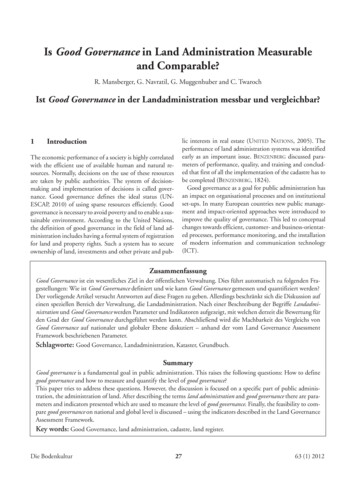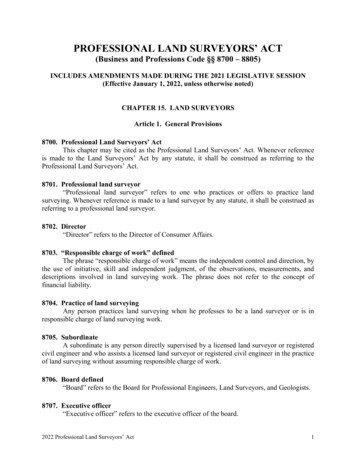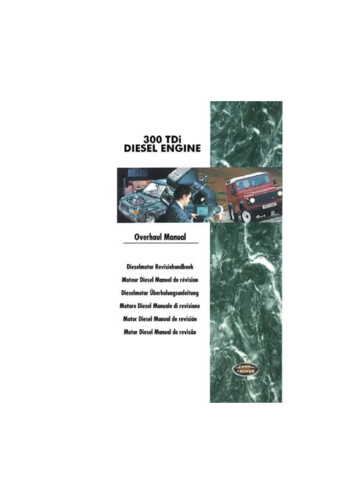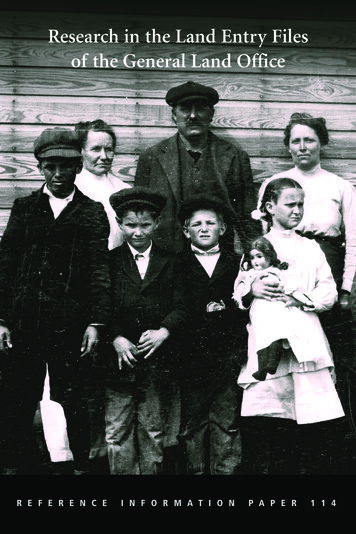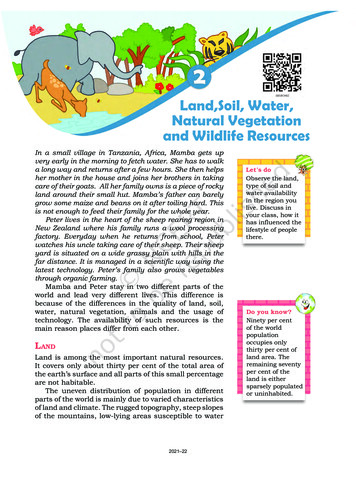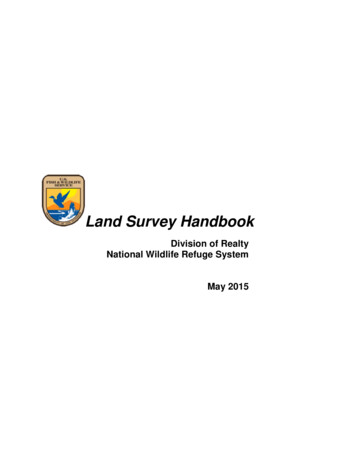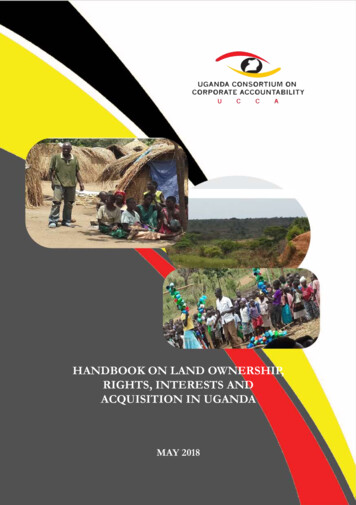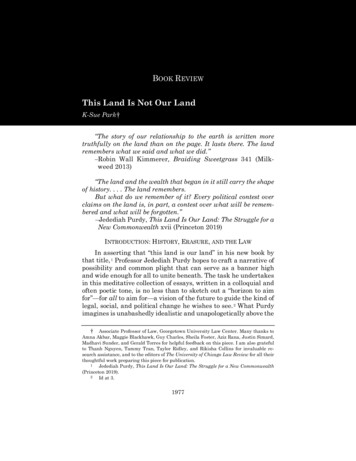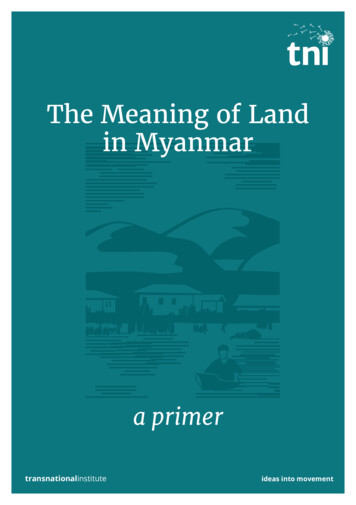
Transcription
The Meaning of Landin Myanmara primertransnationalinstituteideas into movement
AUTHORS: Jenny Franco, Hannah Twomey, Khu Khu Ju, Pietje Vervest, Tom KramerDESIGN: Brigitte Vos, www.vosviscom.nlPublished by the Transnational InstituteNovember 2015This primer would not have been possible without the invaluable contributions of themany participants in workshops that TNI co-organised with local organisations overthe past years in Myanmar. We are very grateful to them and hope we have capturedtheir lives and insights truthfully. Any omissions or errors are ours.
Contents1What is land and why is it important? 42 Why is land such a burning issue in Myanmar? 83 How is land related to debates about development? 164 Is there a human right to land? 215 What steps are people in Myanmar taking toexpress and assert their human right to land? 28
1 What is land and why is it important?The United Nations’ Food and Agriculture Organization (FAO) definesland as “a delineable area of the earth’s terrestrial surface, encompassingall attributes of the biosphere immediately above or below this surfaceincluding those of the near-surface climate the soil and terrain forms, thesurface hydrology (including shallow lakes, rivers, marshes, and swamps),the near-surface sedimentary layers and associated groundwater reserve,the plant and animal populations, the human settlement pattern andphysical results of past and present human activity (terracing, water storageor drainage structures, roads, buildings, etc.”)1As this definition suggests, and what warrants stressing here, is that land isvitally important for one very significant reason: people. Human existenceis so inextricably linked to land that it makes little sense to talk about landwithout also talking about human activity and the history of human beingson this planet.“States should strive to ensure responsible governance of tenure becauseland, fisheries and forests are central for the realization of human rights, foodsecurity, poverty eradication, sustainable livelihoods, social stability, housingsecurity, rural development, and social and economic growth.”Paragraph 4.1 of the Tenure Guidelines of the UN Committee on World FoodSecurityAdding humans both clarifies and complicates the picture. How people relateto the land can vary from one place to another, revealing the importance ofdiverse landscapes (e.g. rolling hills, flat valleys, thick jungles, rocky mountainridges). How humans relate to the land may change over time too -- dueto seasonal cycles (e.g., rainy and dry season) or more long-term climaticgeological changes (e.g., El Nino weather patterns or earthquakes).4
Meanwhile, human society itself is varied, leading to not one singleexperience and perspective, but multiple experiences and perspectives. Aslong as there have been humans on the planet, land has been important fora variety of reasons that include, and go beyond, single physical plots of land.“Land is our life as well as our prestige. It’s the food for usto survive, the home for us to live, and the place of unity forour family. Also land is our precious inheritance throughoutthe generations” — A farmer, Paungtawchi Village, TaunggyiTownship, Shan State.Land has been essential to many kinds of human practices and to thebuilding of diverse human societies. Land has shaped human society alongseveral dimensions: economic, social and cultural (including spiritual), as wellas political dimensions. Consider, for example, jungles, forests, mountains,deserts, steppes, swamps, marshes, mangrove coasts, the open sea, and thepolar regions. For some people, these places are inaccessible, inhospitablebackwaters. But for others they may be sanctuaries: sought-out protectedspaces where people seek refuge from state authorities, or from othercivilisations, outsiders, intruders or newcomers.What land is and what it means to us is found in many diverse relationshipsthat humans have built over time with people and other life forms inthe landscapes where we live. These relationships express particularunderstandings, perceptions and choices regarding our place and role in theworld. The phrase “the multi-dimensional character of land” is a referenceto all the possible ways in which land holds meaning for people and in whichpeople find meaning in land.Humans have the capacity to conform to the land and landscapes weencounter -- for example, land influences where we settle, how we feedourselves, what materials we build our homes with, who we worship, whichspirits we perceive in the air, and it informs our stories of where we comefrom and why we are here. Some upland societies in Myanmar such as theKachin, Lisu, Akha and Lahu, for instance, “have a legendary creator-god, adualistic male-female figure who formed the heaven and the earth”, which inthe past occasionally inspired the rise of movements led by priests, prophetsor holy men “to resist subordination to valley-states”. 25
But the reverse is true too. Humans also have the capacity to alter the landand landscapes we encounter. We have often sought to make the land adjustto our own visions of how it should be. It’s not just that the surface of theearth has been an underlying factor in moulding humanity and influencingwhat we do and what choices we make. Human society has been a hugefactor in shaping and re-shaping the surface of this planet too.Human Society Shapes Land and Landscapesand vice versaThe following examples highlight ways that humans have transformed landand landscapes with significant environmental and social consequences.Hpakant jade minesHpakant, the hotbed of Myanmar’s jade mining industry, which continues tobe plagued by earth-gouging machinery, suffered 7 landslides in 2015, themost deadly of which killed over 100 people after the discarded waste soilcollapsed. 3 In addition to deaths, the dramatic upheaval of land in the areahas been linked to deforestation, pollution of the Uru River, and displacementof people. 4Letpadaung copper mineThe Letpadaung copper mine operations’ assault upon the surroundingenvironment and neighbouring communities has manifested through itsinadequate waste management systems, widespread land confiscations,fenced off farmland, and forced relocation of people.5 Compounding thisenvironmental damage, destructive police forces have utilised highly toxicsubstances and military weapons to ‘secure’ the vicinity amidst residentprotests.6Kyaukpyu deep sea port and Special Economic Zone (SEZ)Unlocking the Bay of Bengal to Chinese interests, the Kyaukpyu SEZ will hostindustrial and commercial clusters as well as a deep sea port welcoming100,000 ton oil tankers, whilst simultaneously dislodging 40 nearby villagesin areas with Rohingya communities, intruding upon Myanmar’s secondlargest mangrove forest, and damaging farmland and fishing areas.7 Itspotentially devastating and toxic effects upon the ecosystem, human health,6
and livelihoods will be magnified by the imposing Shwe oil and gas pipelinealready traversing the area.Dawei deep sea port and Special Economic Zone (SEZ)Slated to engulf 196 sq km of coastal land, the Dawei SEZ will host a deepsea port linking Myanmar with Thailand, and massive industries such as apetrochemical power plant and steel mills. 8 The SEZ is anticipated to encroachupon the lives of 22,000 to 43,000 people, and has already destroyedfarmland, severely polluted bodies of water with heavy metals and fertiliserchemicals, blocked access to coastal areas for small-scale fishing, and tripledlocal cancer rates.9 In swallowing up dozens of seaside fishing villages, Daweiis projected to swell into Southeast Asia’s largest industrial and trade zone.Myitsone hydropower damWithin politically-sensitive, biodiverse, and seismically-active Myitsone,construction of the world’s 15th largest hydropower dam within 62 milesof the Sagaing major fault line jeopardises over 300,000 people livingdownstream in Kachin State’s capital and could spark “irreversible damage toBurma’s key river system”, 10 including altering downstream flows that governrice production and aquatic migratory patterns as well as river salinity.11Anticipated flooding of 766 sq km of land has already displaced 12,000people from Kachin’s cultural heritage hubs, representing the confluence ofecological and identity theft.12Hat Gyi hydropower damComparable to Myitsone hydropower dam, the location of the Hat Gyi damwithin an ethnically diverse, wildlife-rich, earthquake-prone, and war-tornarea along the Salween River serves as the ignition to drastically alterthe living landscape.13 Increased military presence to secure the dam hasalready escalated fighting and refugee flows, whilst environmental concernsover aquatic life habitats, deforestation, flooding of farmlands, losses ofbiodiversity, and increased seismic activity remain unaddressed.147
2 W hy is land such a burning issuein Myanmar?Today the country is facing a serious land problem. Land is a burning issue inMyanmar for several reasons.First, the current land problem is linked to ethnic conflict. Myanmar is oneof the world’s most ethnically diverse countries, with ethnic minoritiesmaking up an estimated 30-40 percent of the total population, and ethnicstates (home to mostly poor and often persecuted ethnic minority groups)occupying some 57 percent of the total land area.Ethnic minority groups have long felt marginalised and discriminated against,resulting in a large number of ethnic armed opposition groups fighting forethnic rights and autonomy, against the central government dominated by anarrow elite segment of the ethnic Burman majority. Systematic exploitationof the natural resources in these areas by the central government hasensured that economic grievances likewise play a part in fuelling civil war.15The country has experienced more than 60 years of devastating civil war.Most of the people living in war-torn areas are ethnic minority farmersengaged in upland cultivation using customary farming practices passeddown from earlier generations, and whose relationship with the land isspiritual, cultural and social.‘Land has very deep meaning and value for us. It is our lives andthe very blood in our veins. Without our land, our nationalitywill vanish. Land is our dignity.’ — Kayah farmer, Dawsoshayvillage, Demoso Township, Kayah State.Land grabbing and armed conflict have uprooted and dispersed familiesand forced many people to flee into economically precarious and politicallyuncertain situations as internally displaced people (IDPs) or as refugees livingin camps along the borders with Thailand and China.8
Second, in Myanmar today land is being revalued in a dramatic way bypowerful economic actors as they try to grab control of land and othernatural resources like water, forests, fisheries and the oil and minerals inthe soil. This shift toward a singular meaning of land is being pushed byextractive, exploitative and predatory business practices and unrestrainedrent-seeking behaviour by empowered political and economic elites aimed atcontrolling land, water, mineral, forest and fishery resources and the benefitsof their use.This trend is being encouraged and codified by several new land-related lawsand policymaking processes in the corridors of the state. A series of landlaws designed behind closed doors and promulgated in 2012, changed thelegal basis for land use rights, especially in the uplands, while establishing alegal land market in order to encourage domestic and foreign investment inland.Under the Farmland Law, plots of land can be legally bought and sold withland use certificates (LUCs), thereby inaugurating a land market based onWestern-style (individual) private property rights. The legalisation of aland market without strong public safeguards has opened the door to anew generation of problems:“Under this new law, farmers who have beengrowing on hereditary land for their livelihoods can only possess landby means of official registration. As the registration process is not easilyaccessible for rural people, the land policies put them at risk. In most cases,they are helpless”.16Under the Vacant, Fallow, and Virgin (VFV) Land Law, land that is notcurrently titled and being used in certain ways is seen as a ‘wasted asset’. Thecentral government can redefine untitled farm and forestlands – both uplandshifting land, especially fallows, and lowlands – as vacant, fallow or virginland and reallocate them to domestic and foreign investors. This also appliesto community-managed resources, such as village forests, waterways,fishponds and grazing lands, which become susceptible to confiscation,despite being crucial to local livelihoods and food security. The law allowsindustrial crops to occupy up to a maximum of 50,000 acres for a thirty-yearlease, with the possibility for renewal.9
To those who have been living and working in these areas and whose visionsof the future depend on being able to keep living and working there, the ideathat their land is being labelled and grabbed as ‘vacant land’ is absurd andoffensive. It is absurd because so-called vacant land does not exist.‘We do not accept the land classification of “Vacant, Fallow,Virgin Land”. There is no “vacant, fallow, virgin land” in ethnicterritories.’ — from the statement of the Ethnic CommunityDevelopment Forum and the Customary Land Rights ProtectionCommittee, concerning Myanmar’s National Land Use PolicyDraft, 6 November 2014, Mae Sot.These new land laws put many communities under threat of losing theirlands, many of which have already been targeted for resource extraction,agribusiness concessions, and mega infrastructure projects. The new lawsundermine their right to land, including their right to decide how they willuse and manage their farms and forestlands, as well as their right to foodand water, among others. Simultaneously, the right of return of hundreds ofthousands of IDPs, refugees and migrants who used to occupy and use landin these areas is forestalled.Third, the long-simmering land problem has become a burning land problemwith the start of yet another new wave of land confiscations. Throughconfiscation, the control of land previously occupied and used by mainlypoor, marginalised and vulnerable people and groups of people is beingtransferred to other kinds of actors intending to use it for different purposes.The wave of land grabbing since 2010 is occurring on top of and in interactionwith previous waves of land grabbing. Evidence suggests the amount of landlost in these previous waves is significant and may even be larger than whathas been lost under the current wave of land confiscations.What is being lost as a result of all this? What is being lost are the manymeanings and uses and relationships around land that fall outside of thenarrow boundaries of land as an economic factor. The meaning of land tothe people and peoples of Myanmar cannot be reduced to one-dimensionaleconomic interest. Land is too precious and significant for that. What isincreasingly ignored or dismissed by national and international policy10
makers today are the perspectives of ordinary people whose past, presentand future is directly tied to staying on, or returning to, the land. Their storiesare important and insightful, revealing profound perspectives on land andtheir relationship to it. Here are just some of their voices and perspectives.Land is livelihood and life with dignity. Without land, thereis enslavement, struggle, fragmentation, and mere survivaldevoid of dignity and self-determination.“I am not an educated person, I am just a farmer. But wefarmers know professionally how to grow and work on the land.Our lives depend on the land. People (authorities) confiscatedour land and built buildings on it without discussing andnegotiating with us. Now we don’t have land to work and don’tknow how to work in other places. We find it very difficult tosurvive without having land to work.” — A male farmer, DaweiTown, Dawei Township, Tanintharyi Region.“We plant vegetables and tomato, and also do Taungya on ourland. I cannot measure the value of the land and it’s essentialfor my family to survive.” — A male farmer, Mee Tway Chaungvillage, Pinlaung Township, Shan State (South).“Land is like our vein; it is vital for our living. After our landwas confiscated, we don’t know what to do for our livelihood. Ithas become very difficult for us. Since 20 years ago, we workedon our land and also planted long-term types of plants. Butour land is confiscated now.” — A farmer, Nankway, MyikyinarTownship, Kachin StateLand is freedom from exploitation and slavery. Land is self-determination;having their own land allows people to determine how they will farm andwhat they will plant, where they will graze their animals, where they will burytheir dead, and what investments they will make toward the future.11
Land is also inheritance with remembrance.“Land is very meaningful for us not only for our livelihoodbut also as an inheritance to work on and relay across thegenerations.” — A farmer, Tarmoenye Town, Kutkai Township,Shan State (North).“Land is one of the resources that is a gift from Nature tosurvive and our livelihoods depend on it. I worry for my latergenerations since I don’t have land to give as inheritance, and Ibelieve only land can guarantee for the long-term a livelihoodfor them.” — A farmer, Meetouk village, Pinlaung Township,Shan State (South).“Land is very important and precious to me and my family.My husband passed away in the same year that our land wasconfiscated. My husband had planted bamboo on our land forthe last 30 years, and now the bamboo plants are very big. Iinherited the land from my grandmother and my mom stepby-step. I want to work again on my land.” — A female farmer,Shwe Pyi Thar ward, Myitkyina Township, Kachin State.Land is family integrity and togetherness.“Our grandparents worked on the land and relayed thegenerations (to us) as inheritance. We have worked together asa family, but now our family members have to work separately.We don’t have our land now to work. Some have had to migrateoverseas and others are now working for daily wages atdifferent places in town.” — A farmer, Lwot Kyan village, NantSan Township, Shan State (South).“Land brings unity in my family. When we had our land, weworked together and farmed the land. Our family livelihooddepends on the land. I love my land as my life and my family.Land is also the basic foundation of my family to survive. I can’timagine the future of my family if I don’t get back my land.”— A farmer, Mingalar ward, Aungban Township, Shan State(South).12
“We don’t have our land to work anymore. My children areworking as migrants in another country and I worry about theirworking conditions. I want to live together with them. I wantto get back my land so my children can come back and worktogether with the family in the same place.” — A farmer, PainNyaung Village, Lashio Township, Shan State (North).Land means family continuation across generations. Landis knowledge passed from one generation to the next.“Land is like a rice pot that our family depends on for our livingsince we’ve been born and it is very valuable for us. We don’twant to lose our pot, and also we value our land as what weinherited from our grandparents. Without this land, we worrythat our family’s next generation will become workers like aslave in uncertain conditions just to survive.” — A farmer, TarPat (East) village, Maubin Township, Ayeyarwady Region.“We cannot measure the value of our land. Land is verymeaningful for us and we have traditionally worked on theland for a long time since our grandparents’ time. We growpaddy and in the dry season we grow vegetables on the land.We have enough income to support all the family’s needs anddo not need to worry for food.” — A farmer, Dawei Town, DaweiTownship, Tanintharyi Region.Land is the link between people’s past, present and future;it connects lives from the past with those in the present andto a foreseeable future.“Land is like my life. Also my family’s livelihood depends onland. We want to get back our lives and future.” — A farmer,Panmati ward, Myitkyina Township, Kachin State.“Land carries the history for us. In our grandparents’ era, therevolution council era, they fought for the country and got the13
land. Then they lived here and worked on this land, and theypassed the land as inheritance to their later generations. Landis like a remembrance of them.” — A farmer, No.5 village, NantSan Township, Shan State (South).“When we had our land, our family worked together on it andwe could take care of our children very well and support themnearby. But since our land was confiscated, we have to strugglefor our livelihood and we have to work separately, dependingon daily-wage jobs. We also can’t look after our children closeto us and can’t also support them. In our village, some kids andyoung people have to drop out of school and have no land towork. So then some of them start to use and trade drugs in thecommunity. Land is the future for young people also.”— A farmer, Panmati ward, Myitkyina Township, Kachin State.Land is individual identity.“Land is essential for me; especially our livelihood depends onthe land. I am a farmer and we can’t farm without land. SinceI was born I have worked on the land, doing farming, and nowit seems like we can’t do other work without land.” — A farmer,Warmayan village, Bago Township, Bago Region.Land is ethnic identity; land is community.“Land has very deep meaning to us. We value it and it’s likeour lives and our veins. If we don’t have our land, our (Kayah)nationality will vanish. Land is our dignity.” — A farmer,Dawsoshay village, Demoso Township, Kayah State.“In our community, we should have communal land. Weplanned to build clinic, pre-school and ward developmentoffice. But our communal land was confiscated and we areprotesting to get it back.” — A farmer, Htantabin Village, MoeNyin Township, Kachin State.14
Land is education and health.“(Providing) food for my family and education for my childrendepends on land. We farm on our land and our family doesn’tneed to worry for anything that we may need. We have enoughfood and everything for my family.” — A female farmer,Htantabin village, Moe Nyin Township, Kachin State.“When we have worked on our land for one year, we could donothing and still have enough food for our family for 2 years.Now we don’t have land to work and we are struggling forour livelihood. We have to worry for our food, and have noguarantee for supporting our children’s education and health.”— A farmer, Kay Hnin village tract, Lashio, Shan State (North).Land is safety and security.“We have been staying in our land since a long time ago.Our livelihood and lives depend on the land. We feel safe towork and live in our land. If we have land to work on, ourfood, livelihood, money, and other needs of our family areguaranteed. Now since we lost our land we worry for ourfuture.” — A farmer, Dawlawku village, Phruso Township, KayahState.“Land gives security to our family. We don’t have land to worknow and my family members have to migrate to other country.”— A femalefarmer, Ka Myaut Kin, Dawei Township, TanintharyiRegion.“We have grazing land for the community. We can confineour cows and livestock to feed in these areas. Without grazingland, where can we keep our cows? Also in these areas there arevegetables growing naturally and any of the villagers can freelyget vegetable from that land.” — A farmer, Par Kyu village, 38miles, Kaut Khine Township, Shan State (North).15
“Land is like our mother who gave birth to us and feeds us. NowI don’t have my land and I have to work as a daily wage-workerdoing (random) work.” — A farmer, Shwe Pyi Thar ward (2),Myitkyina Township, Kachin State.“Since we have grown up, we do farming with the land andare able to support our family for food and livelihood. Landis inherited from our parents and essential for us. We can’tmeasure the value of our land.” — A farmer, Warmayan village,Bago Township, Bago Region.The value of land cannot be measured; land that is takenaway can never be properly compensated.“Land is like our vein and we can’t live without it. If you cut theroot of the tree, the tree can’t grow up and sooner or later it willdie. It’s similar to our lives without land.” — A farmer, Panmatiward, Myitkyina Township, Kachin State.All over the country, there are people whose relationship to the land goesfar beyond the physical and economic boundaries of individual plots ofearth. These wider and more socially meaningful meanings of land include:lifestream, history, sacred spirits, homeland, livelihood, sanctuary, safetynet, daily life space, sacred places, watershed, inheritance, life with dignity,and last but not least, gift from Nature.3 How is land related to debatesabout development?Land is valued throughout the world, especially by those who live in closerelationship with the Earth’s natural endowments. Millions upon millionsof families across the globe live in a close relationship with land and itsassociated waters, soils, forests, fisheries, flora and fauna for reasons and inways that may not always be visible to the naked eye.16
For some people, however, the lives and practices of peasants andpastoralists, fishers and forest dwellers, are basically irrelevant. Theyare merely irritating or even destructive obstacles on a predeterminedpath to (someone else’s) profit and power -- one that may be strewn withharmonious words and abstract logics that we are told are good for us:economic development, environmental protection, poverty alleviation,employment generation, food security and the like. This ill-logic at work isoften all consuming – erasing lives past and present and preempting futurelives; enclosing living landscapes and reducing them to polygons demarcatedon a map, waiting to be bought, sold and used until usable no more. Liveswhich once cultivated these spaces become swept away, and people areforced to adjust as best they can to something not of their own choosing.To understand how land is related to debates about development inMyanmar today, we have to look at what lies ahead for different peopleand what will remain if the current trends continue unabated. Today acrossMyanmar there are very different visions of development competing forcontrol of land and territory and related natural resources therein. Thediverse visions at play on the ground involve very different logics of securityand wealth creation; different priorities; and different starting points fordefining what is land tenure security in particular and what is good living ingeneral.There are many business oriented projects and initiatives that areincreasingly hitting the ground across the country, but they come fromone general point of view of what development means – and it is one thatdoes not necessarily reflect or respond to the aspirations of all of thepeople in Myanmar. The examples mentioned earlier – Hpakant jade mines,Letpadaung copper mine, Kyaukpyu deep sea port and special economiczone, Dawei deep sea port and special economic zone, Myitsone hydropowerdam and the Hat Gyi hydropower dam -- are just some of the more visiblelarge-scale capital-intensive, resource-depleting projects and initiatives inthis vein and are part of a larger trend taking place around the world, notonly in Myanmar.Another kind of change often packaged as development is related to farmingand agriculture. In the past and even today around the world, many differentkinds of farming systems and agricultural practices are in place. Today’s17
global land rush is also having a big impact on agriculture, changing the wayfarming is done in many parts of the world including Myanmar. The changethat is happening is usually in one overall direction. That is, moving societiesaway from small-scale, labour-intensive uses like peasant farming – includingupland shifting cultivation practices, as well as peasant fishing, grazingand community forestry for household use and local markets, and movingthem toward capital-intensive, resource-depleting industrial monoculturecorporate enterprises that are linked to metropolitan areas and foreignmarkets.The new agricultural projects are hitting the ground in ways that follow twobasic patterns. First, rural working people are being incorporated into thenew arrangements when the latter need both their land and their labour.Across Myanmar, rural working people are losing their farmland due toconfiscation, but then being offered employment or the possibility of stayingand farming the same land, on the condition of making so-called rentalpayments (either cash or kind) to the new owners. For example, from 1998 to1999, the Myanmar Gold Star Company got permission to do an agriculturalproject on 5195 Ngu Village Tracts in Maubin Township, Ayeyarwaddy Region.The company allowed the farmers to continue working on the land by leasingit back to them with 7 baskets of grain per acre until 2013, and then in 20142015 sued 30 of the farmers for failing to make the lease payment.17Second, it is also often the case that people are being driven off theirfarmland entirely. In the case below, from Nam Tawng Village, Pan Sai (KyuKoke) Sub-township Village Tract in Muse District, northern Shan State, whatwas needed by the new enterprise was their land, but not their labour:“In 1996, 2006 and 2008 with the cooperation of local authorities, fourbusiness cronies confiscated 338 acres of land. Local ethnic people hadlived on and farmed these lands since their ancestors’ time, and farmingwas their main source of livelihood. The reason given for the confiscationwas that the land was to be used for a government agricultural project.The confiscated areas included 50 percent of the villagers’ best farmland(good, fertile, flat), of which a portion was then rented out to Chineseworkers for a sugarcane plantatio
ecological and identity theft. 12 Hat Gyi hydropower dam Comparable to Myitsone hydropower dam, the location of the Hat Gyi dam within an ethnically diverse, wildlife-rich, earthquake-prone, and war-torn area along the Salween River serves as the ignition to drastically alter the living landscape.13 Increased military presence to secure the dam has


